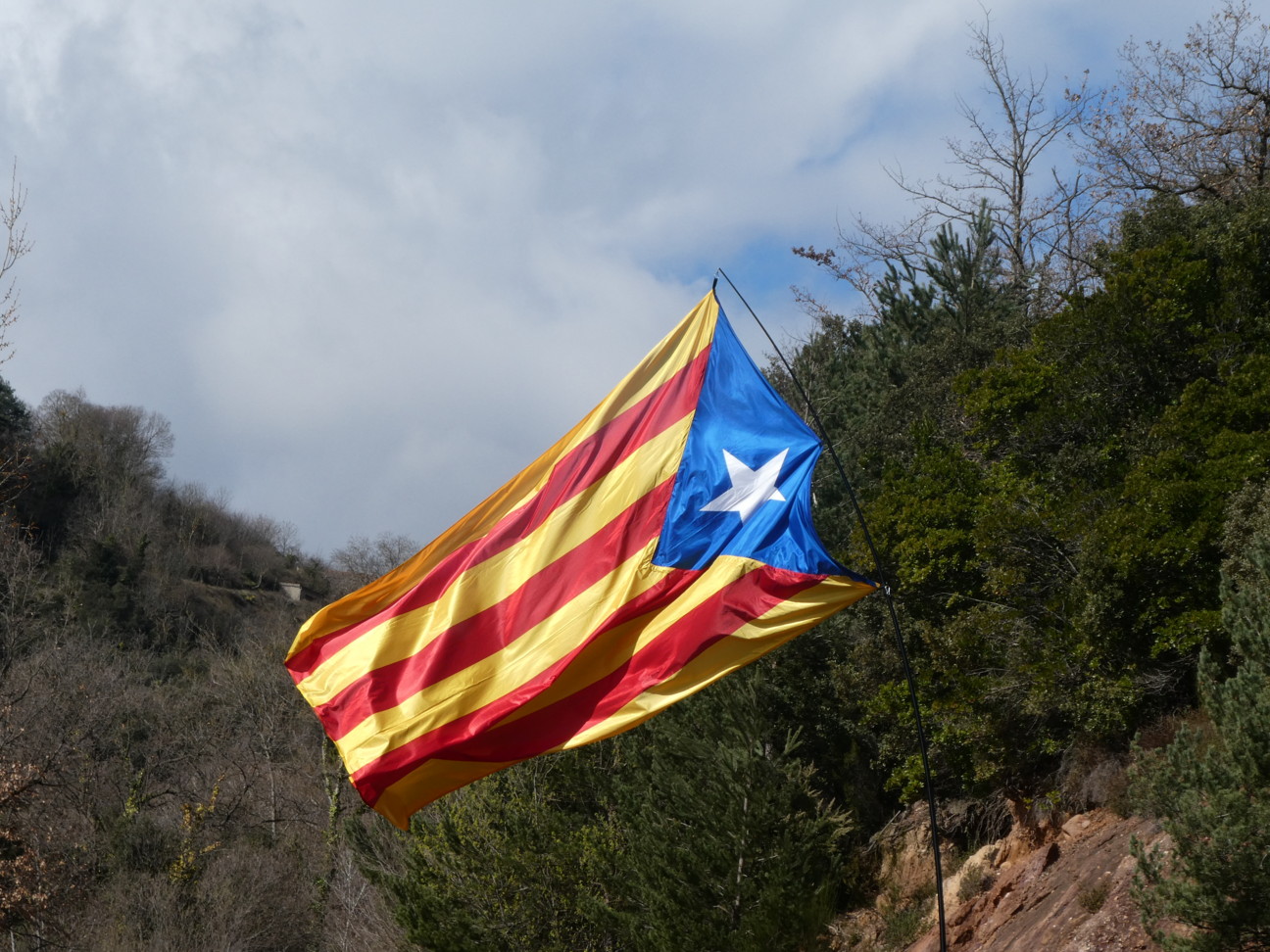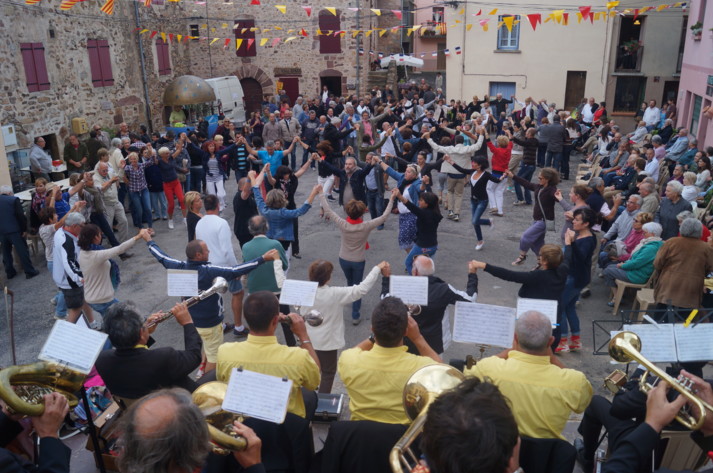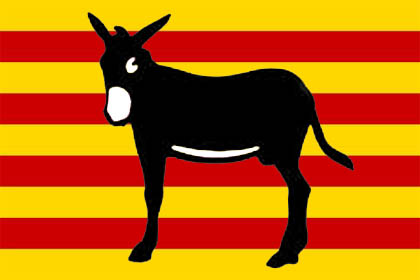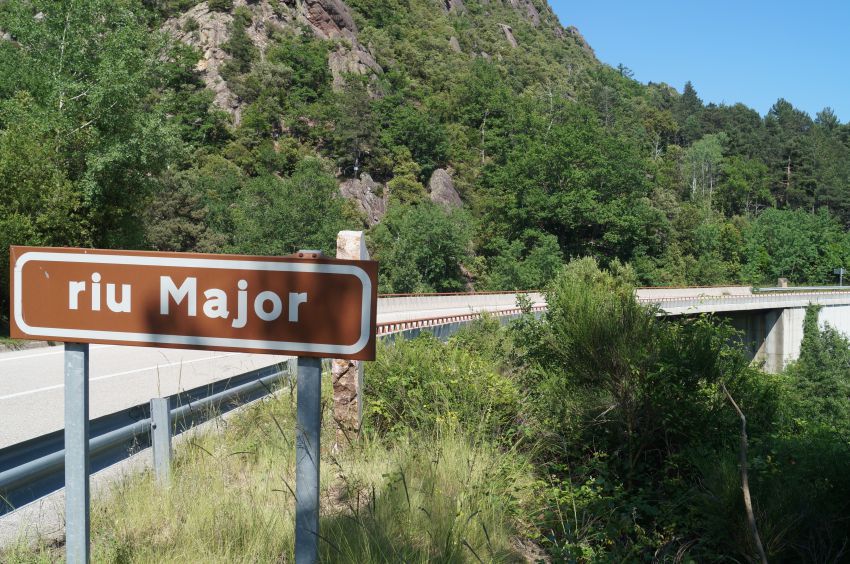CATALONIA
This part of France is also known as North Catalonia by those who consider it part of Catalonia. Barcelona is the capital of the (south) Catalonia which covers an area of 32,114 km² and has an official population of 7,504,881. The area in France now known as Rousillon, was in once part of Spain but has been French since it was ceded to France in 1659. It was this region of North Catalonia, with Perpignan as its capital. The Catalan language was forbidden by Franco thus reinforcing it’s importance along with its culture to the Catalan people. The language and culture are important here not only to those who consider it part of Catalonia and not France, but as can be witnessed by the road signs, written information, regional events etc. to the population in general. Locally it is spoken by many people although the younger people use French as their first language whereas their grandparents used Catalan.
THE CATALAN FLAG
There is legend and there is historical record! Too long to put it all in here, but it is an interesting story and this flag is an important symbol to Catalans especially to Catalan independentists. An internet search will privide you with some interesting reading and a better understanding of what the flag symbolises.

THE SARDANA
At many festivals, you are likely to see circles of people dancing the sardana, Catalonia’s national dance, and one which resembles no other dance. Its origins are thought to lie in the graceful dances of ancient Greece. One theory is that the Greeks introduced the dance during the period in which they maintained trading posts on Catalonia’s northern shores thousands of years ago. Others insist that the sardana was not practised here until the fifteenth-century Catalan occupation of Sardinia, hence the name. In any case, the sardana in its present form emerged during the 19^th^ century Catalan renaissance and it has become a symbol of national identity. In northern Spain it was danced on Sundays outside churches after the service as a sign of defiance under Franco’s rule. Catalan was forbidden to be spoken so the dancing was a way of expressing the Catalan identity.
Sardana dancers link hands, forming circles which grow bigger and bigger as more people join in. Traditionally, anyone can join in at any point (there is no need to be equal men and women and you don’t need a partner) but cannot cut in between a man and a woman to the right of him. When the circle gets too big, the dancers form more circles. At festivals several concentric circles will be formed. People of all ages and ranks in life join hands and dance as if to emphasize that whatever their differences, they are first and foremost Catalans. The spirit of unity generated by the sardana is truly impressive. The dance looks deceptively simple to the onlooker but is an extremely disciplined dance calling for exact movements and expert timing, provided by a leader in each circle. The first part consists of short steps and the arms of the linked circle are kept lowered. When the livelier long steps start, signalled by a noticeable change in the music, everyone raises the linked circle of hands at exactly the same moment. For this reason, unless you think you’ve really got the knack, it’s generally inadvisable for visitors to join in – one wrong move can put the entire circle out of step. Traditional costume is worn for the bigger festivals but even for those dancing in everyday clothes at smaller festivals, most wear vigatanes (wedge-heeled espadrilles).
Music for the sardana is played by a cobla, a band consisting of 10 wind instruments, double bass and a tamborí (very small drum) played by 11 musicians. The cobla has five woodwind instruments: the flabiol which is a small fipple-flute, and the tenora and tible (two of each) which belong to the oboe family. These and the tamborí are typical Catalan instruments. The brass instruments include: two trumpets, two fiscorns (a type of saxhorn created by Adolph Sax during the 19^th^ century), and a trombone. The double bass was traditionally a three-stringed one, but now the part is usually written for and played on the modern (four-stringed) instrument. It is not possible to describe the music, the instruments are not exactly like ones we know in our orchestras. The music is best described as melancholy and joyous by turn.

DONKEY SYMBOL
You will see on the rear bumper of many local cars a sticker with an image of a donkey. This sticker comes in various versions including one with a the Catalan flag draped over the donkey.
The "ruc català" or "burro català" (Catalan donkey) is a relatively recent symbol of Catalonia. It was chosen when the need was felt in Catalonia to produce something genuinely Catalan as oppose to the Spanish Osborne bull. The bull was perceived by Catalans as a centralistic symbol, alien to their culture. The choice is said to have been because the Catalan donkey is more intelligent than the Spanish bull and is known for being stubborn, considered a characteristic of the Catalans; not to mention the other accoutrements with which donkeys are endowed

THE CROSS BORDER BRIDGE
Since the dawn of time the mountain pass at Coustouges has been a convenient crossing place. The Roman road which passed here still exists as does the track known as « la carrerade » used for the transhumance, the moving of livestock to higher or lower pastures according to the season. There have been mule routes too and of course smuggling ones.
On record since 1880 and most likely even before, people on both sides of the frontier wanted to

create a direct route across the seemingly impassable ravine.
Successive politicians joined the cause but it was not until May 1995 that the last link in the chain was finally achieved! This is the bridge which straddles the River Major just below Coustouges, frontier stream between Vallespir on one side and Empordà on the other. Long awaited, after much campaigning, delay and policiticking, it is the 6th road link in the Eastern Pyrenees between France and Spain.
 Site créé en partenariat avec Réseau des Communes
Site créé en partenariat avec Réseau des Communes